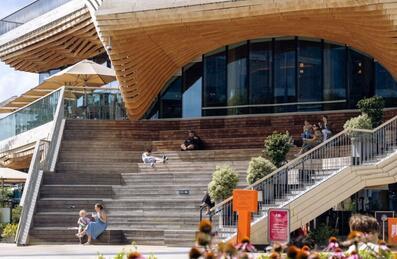
Popular Searches:
Keep up to date
Sign up today for exclusive offers and incredible experiences you won’t want to miss at Queen Elizabeth Olympic Park.
Sign up nowHOUSING SURVEY HIGHLIGHTS IMPORTANCE OF HIGH QUALITY DESIGN TO IMPROVE ENERGY EFFICIENCY AND COMBAT CLIMATE EMERGENCY
HOUSING SURVEY HIGHLIGHTS IMPORTANCE OF HIGH QUALITY DESIGN TO IMPROVE ENERGY EFFICIENCY AND COMBAT CLIMATE EMERGENCY
Press Release 03/10/2022
- Survey results highlight lower energy usage in Park homes than average UK new-build home due to quality of design and build
- Residents have high overall satisfaction with homes and new neighbourhood
- Findings will help deliver energy improvements on future Park neighbourhoods to meet net zero targets
Results published by London Legacy Development Corporation (LLDC) from its pilot Post Occupancy Evaluation (POE) Study at Chobham Manor underline the importance of good design to tackle climate change.
The findings show that the 259 homes built in the first phase of the housing development on Queen Elizabeth Olympic Park outperform the average UK new build home in terms of electricity, water and heat.
The utility data showed that the homes were well insulated and used less energy compared to the current UK average for new-build homes due mainly to the energy efficiency standards put in place at the start of the project.
The average amount of electricity used in the homes was 31.5 KWh per sqm compared to 42 KWh per sqm for the average UK new-build home. The average annual space heating was 28 KWh per sqm compared to 50 KWh for the average UK new build. Water usage was 126 litres per day compared to the UK average of 142.
As utility costs continue to rise, the results of a new study will help residents manage their utilities better and improve the design of future neighbourhoods on Queen Elizabeth Olympic Park.
The overall results of the study are positive and confirm that residents feel Chobham Manor is a family friendly area, where people have strong social networks, with some residents describing the 880-home neighbourhood as place that ‘is in London, but with the feel of a small town’.
Areas with higher satisfaction included:
- 87% overall satisfaction with the neighbourhood
- 79% positive about their homes
- 64% of the residents said they plan to stay for five or more years
- 89% were satisfied with levels of daylight
- 80% satisfied with winter temperatures.
Areas with lower satisfaction included:
- 33% satisfied with temperature in summer
- 50% satisfied with levels of external noise
- 36% were satisfied with their usage of district heating.
Rosanna Lawes, Executive Director of Development at LLDC, said:
“It’s so important that we match the care and effort that goes into designing and building our neighbourhoods with a review of how those buildings work when people move into them. By understanding how people use their homes and the spaces around them we can make sure we learn the lessons for future neighbourhoods and share with the wider industry as we build thousands more homes on and around the Park. It’s vital to share and use the knowledge we gain to help tackle the climate emergency.”
Louisa Bowles, Partner and Sustainability Lead, Hawkins\Brown, said:
"This was a trailblazing study in that it sought to understand the wider social impact of a development in addition to its energy use. Our specialist social research team analysed residents' feedback to help the LLDC gain a clear picture of how design contributes to a desirable place to live. The results showcase how a well-considered project brief has a direct correlation with a positive POE outcome, which should embrace environmental as well as social sustainability. A research project with this level of complexity needs an enlightened and determined client. We hope that studies of this nature become commonplace in the future to help nurture resilient communities."
Dr Mark Dowson, Associate Director, Buro Happold, Sustainability and Building Performance
“The Chobham Manor Phase 1 post occupancy evaluation (POE) was a pioneering study facing into many perceived industry challenges. These included resident engagement and data protection - all while safely adapting and conducting the studies during a global pandemic. This independent and holistic approach gathered insights from user feedback, technical evaluations including energy, water and environmental comfort, as well as lessons learned from project delivery. We hope the findings build confidence in the value of POE and accelerate its uptake in future. We believe it is a critical mechanism for ensuring neighbourhoods are thriving and resident views are heard”
The innovative study was developed by a team led by Buro Happold Engineers, with Hawkins\Brown leading on resident engagement and Soap Retrofit undertaking utility monitoring.
Residents’ views on a broad range of topics from community and safety through to how people can control temperature and utilities in their home. This was done via surveys, focus groups, home interviews, and collecting information on use of utilities.
The POE pilot study provides information for both residents and LLDC, on how Chobham Manor is as a place to live, as well as about how people feel about the design of individual blocks and homes. The study also helps LLDC to understand demographic information on who is living there, and what people feel about issues like cycling or accessibility. Drawing on this robust evidence, the report sets out recommendations on achieving best practice in design and management of new neighbourhoods as well as building performance of new homes.
LLDC plans to share the methodology used on the pilot study in order that this can be used more widely by other bodies including those within the GLA and local authorities.
Following the success of the pilot study, LLDC has launched a POE study for Phase 2 properties and plans to undertake them for residents moving into properties built during phases 3 and 4 as well as East Wick phase 1, covering 923 homes in total. A consultant team is in place to deliver this phase of the project made up of UCL and the 4 Housing Architects (4HA) group of practices, comprised of PRP, HTA, Levitt Bernstein and Pollard Thomas Edwards.
Notes to Editors
- A copy of the POE evaluation report is available on the LLDC website.
2022 is a special year for Queen Elizabeth Olympic Park marking 10 years since the world’s spotlight shone on London for the 2012 Olympic and Paralympic Games. In that time the Park has delivered on its legacy promises creating a must-visit destination for east London attracting six million visits a year, world class sport and entertainment events, thousands of new homes and two new business districts. That progress continues with more homes and jobs to be delivered and projects like East Bank, the most ambitious cultural and education district the country has seen for a generation, set to open soon. It is a legacy to proud of and one that will continue and inspire generations to come. #passthebaton
Hawkins\Brown is an architecture practice based in London, Manchester, Edinburgh, Dublin and Los Angeles. Founded more than 30 years ago and now run as an employee-owned trust, the firm brings a collaborative approach to projects across a range of types and scale in six main sectors: Civic, community & culture; education; workplace; transport & infrastructure and residential. Hawkins\Brown conducts industry-leading research on key topics such as sustainability and social value; the practice won the Climate Change category of the RIBA President’s Award for Research in 2021.
Buro Happold is a global consultancy of engineers, consultants and advisers, with a presence in 31 locations worldwide and 2,200 employees. They take a holistic approach to improving building performance across projects, considering a range of inter-related issues such as energy, carbon, health, wellbeing, asset value and productivity. The company has been awarded ‘CIBSE Building Performance Consultancy of the Year’ five years running (2018-2022). For the Chobham Manor Phase 1 post occupancy evaluation, Buro Happold is the project lead managing all aspects of the study with the LLDC.
The homes have been built by Chobham Manor LLP, a joint venture between Taylor Wimpey and London and Quadrant Housing Trust (L&Q), who were selected for the project by the London Legacy Development Corporation.






